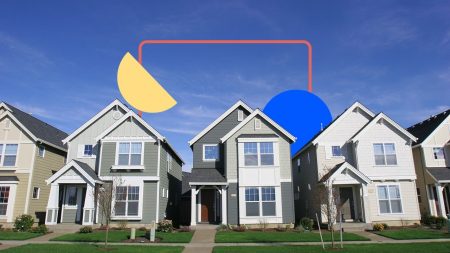Key takeaways
- A HELOC (home equity line of credit) can be a useful tool for paying off credit card debt, as it often has a lower interest rate and a long repayment period.
- Using a HELOC to pay off debt comes with risks, such as the potential to accrue more debt or even lose your home if you can’t make payments.
- You should explore other avenues like home equity loans, cash-out refis and personal loans — and their associated interest rates — before you choosing a HELOC.
If you have a lot of credit card debt, you’d probably love to pay it off all at once. For some people, a home equity line of credit (HELOC) provides the solution. It’s basically borrowing money from a new source to settle the sums you owe the old source — exchanging one debt for another. But this new debt can be easier to deal with.
Here’s what you need to know about using a HELOC for paying off your credit cards: the pros and the cons.
What is a HELOC?
A typical HELOC has a term, or lifespan, of 25 years and includes both a draw period and a repayment period. During the draw period, which might last for up to 10 years, you are allowed to use money from your line of credit up to your credit limit. During the repayment period, which lasts for the remainder of the HELOC term, you will no longer be able to draw from your line of credit and will need to pay back any owed funds. You’ll be paying interest on your HELOC during both the draw and repayment periods, so do some comparison shopping beforehand to secure the best HELOC interest rates.
How to use a HELOC to pay off credit cards
The strategy is simple: You apply for a HELOC — a line of credit based on the percentage of your home you own outright (not mortgaged). Once the credit line is established, you draw against it, and use these funds to pay off your credit card balances.
You’ll have to repay the money you borrowed from your HELOC, of course, but you’ll generally have a long period in which to make the payments: a decade or two. And your HELOC will likely have a much lower interest rate than your credit cards or a personal loan.
Benefits of using a HELOC to eliminate credit card debt
There are several benefits to using a home equity line of credit to pay off credit cards.
You get rid of all your debt at once
Instead of paying off credit card debt bit by bit (with either the snowball method or the avalanche method, for example), a HELOC lets you eliminate it all at once or within a few months. If you are currently feeling overwhelmed by the outstanding balances, using a HELOC can provide significant mental relief.
Your interest rate will likely be lower
The average credit card interest rate is more than 20 percent. In contrast, the average HELOC interest rate is hovering around nine percent as of March 2024. Keep in mind that these are variable interest rates, which means they can go up or down depending on the prime rate. Even if your HELOC interest rate rises, though, it’s still likely to be much lower than your credit card’s APR.
Your financial profile will improve
By paying off those high-interest balances, you’ll have a lot more discretionary income, of course. Your FICO credit score should also increase with the absence of debt on your record. Because a HELOC is secured by your home, its balance doesn’t count in computing your credit utilization ratio, one of the factors determining your score. (The HELOC itself will appear on your credit report, though.)
Why shouldn’t you pay off credit cards with a HELOC?
Using a HELOC to consolidate debt isn’t without its risks.
You might end up in even more debt
Nobody pays off their credit cards with the intention of immediately building up those balances again — but if you don’t practice healthy financial habits, you could find yourself right back where you started, sooner rather than later.
If you use a HELOC to pay off your credit cards and then start using them again, you’ll have both the credit card debt and the HELOC debt to pay back. Plus, during the HELOC’s draw period, you might be tempted to use any leftover credit, accruing even more debt. It can be easy to lose track of how much you’re spending, too.
You might lose your home
HELOC debt is secured debt, which means that if you don’t pay it off in full, the lender has the right to claim whatever you put down as collateral. With a HELOC, that’s your home. When you take out a HELOC, you run the risk of foreclosure if you miss payments or can’t pay back the principal within the designated time period.
You might experience sticker shock
Many HELOCs allow you to repay just interest during their draw periods. If you surrender to that temptation, your monthly payments will abruptly zoom when you enter the repayment period, because they’ll now include both principal and interest. And if interest rates have risen as well, you might find your monthly obligation double or triple its previous amount — which can be a big blow to the budget if you didn’t prepare for the increase.
Is a HELOC or a HELoan better for paying off debt?
Both HELOCs and home equity loans (HELoans) can be effective ways to pay off debt. In the case of credit card debt, though, the HELoan may have a slight edge.
Presumably, you know (or can calculate) the exact outstanding amount on your cards. And presumably, you’d want to clear it as soon as possible because those high APRs multiply balances at a rapid clip. This situation is well-suited for a home equity loan, which disburses a single lump sum that gets repaid in fixed-rate monthly installments. In contrast, with their fluctuating interest rates and long draw periods, HELOCs work well when you’re not sure of the exact sum you’ll need, or for expenses that get incurred over a long period (like college tuition or a contractor’s bill on a long-term construction project).
Plus, home equity loans generally have lower interest rates than HELOCs. (As of this writing, they are averaging 8.4 percent.) Of course, you are locked into paying that rate for the loan’s lifetime.
Here are some other comparisons.
HELOCS VS. HOME EQUITY LOANS
| Expense | Preferable tool | Why it makes sense |
|---|---|---|
| Emergency | HELoan | Probably this is a fixed amount that would be better to repay ASAP |
| Business start-up | HELOC | Expenses are indefinite and will run over an extended period |
| Credit card balances | HELoan | You can add up exactly how much you’ll need to pay off all your plastic, which you’d presumably do all at once |
| College tuition | HELOC | You can withdraw funds as needed just to pay a semester, quarter or half-year |
| Months-long, multi-faceted home renovation project | HELOC | Gradual withdrawals ideal for paying contractor in installments; you have reserves if project has cost overruns |
| Medical bill | HELoan | Better to pay off this bill in total, sooner rather than later |
What are the alternatives to HELOCs to pay off credit cards?
HELOCs aren’t the only debt-settling tool in town. Many of these alternatives mean you won’t have to put your home up as collateral.
Debt consolidation loan
One option is to roll all your credit bills together and pay them with a single debt consolidation loan, one with a lower interest rate. A reputable debt counseling service can help you do this, in addition to providing guidance on how to manage your finances and pay off your balances over time. Be aware that this strategy can have negative consequences for your credit score, though.
Personal loans
Personal loans can be easier and quicker to obtain, and they even have comparable interest rates to HELOCs — if you have a very strong credit score (720 or above). On the downside, their terms are usually shorter.
Balance transfer credit cards
Moving outstanding debt on one credit card onto a new credit card is called a balance transfer. This strategy can help you take advantage of low-low promotional interest rates: You might even find a card with 0 percent APR for a year or two. Just make sure you’ll be able to pay down the debt before that introductory rate period expires.
Cash-out refinance
With a cash-out refinance, you can take advantage of the equity you’ve built in your home over time, as you do with the HELOC. In exchange for taking out a larger mortgage, you’ll get a large chunk of cash, which you can use to pay off your credit card debt. Cash-out refis carry lower interest rates than HELOCs: They’re comparable to prevailing mortgage rates. Of course, that could be higher than the rate on your current mortgage. On the downside, there’s the hassle of having to apply and go through underwriting all over again, plus paying closing costs.
We have a more comprehensive guide to your choices that you can explore, too.
The bottom line on HELOCs and credit card debt
When it comes to repaying what you owe on your credit cards, you have a lot of options — and taking out a HELOC is just one of them. Using a HELOC to settle credit card balances can make good fiscal sense if you own a substantial stake in your home outright — giving you a lot of money to borrow — and the interest rates on your outstanding card debt are in the high double digits.
That said, this strategy comes with its risks, including the risk of losing your home. If you’ve got a good amount of home equity to tap, and can score a low interest rate, it could be the best choice. But be sure to compare the APRs and understand the repayment terms. You don’t want to get blindsided — not when it’s your home on the line.
Read the full article here












